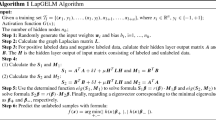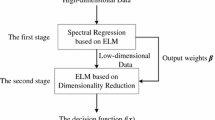Abstract
Extreme learning machine (ELM) has attracted widespread attention due to its simple, quick and good performance. In this work, in order to deal with cross data quickly and efficiently, we first propose generalized eigenvalue proximal extreme learning machine (GEPELM). It takes the form of ratio into consideration to seek for two non-parallel separating hyperplanes in ELM feature space, each of which is close to the samples of its own class and far away from the others simultaneously. Then generalized eigenvalue algorithm is adopted to solve, which incurs GEPELM to enjoy faster calculation speed than TELM. Further, improved generalized eigenvalue proximal extreme learning machine (IGEPELM) is proposed, which uses minus instead of ratio to avoid singular value phenomenon and further mitigate the computational burden by solving two standard eigenvalue problems. To further improve classification performance, generalized eigenvalue proximal extreme learning machine based on inter-class graph (GGEPELM) is proposed, which incorporates the geometric structure information of dissimilar samples into the guideline of GEPELM. In addition, the proposed classifiers are all extended to kernel ELM framework to handle non-linear data more precisely. Moreover, Sherman-Morrison-Woodbury formula is utilized to reduce time complexity of matrix inversion. Simultaneously, a quick solution strategy is incorporated into GEPELMs and GGEPELMs to mitigate the burden of solving large-scale problems. The numerical simulations are carried out on three databases including a benchmark database, an artificial database and a practical application database, which demonstrates the proposed classifiers enjoy high computational speed, good generalization performance and insensitivity to parameters.









Similar content being viewed by others
References
Huang G, Zhu Q, Siew C (2006) Extreme learning machine Theory and applications. Neurocomputing 70:489–501
Huang G, Ding X, Zhou H (2010) Optimization method based extreme learning machine for classification. Neurocomputing 74:155–C163
Wang Y, Yang L, Yuan C (2019) A robust outlier control framework for classification designed with family of homotopy loss function. Neural Netw Offic J Int Neural Netw Soc 112:41–53
Barreto G, Barros AP (2016) A robust extreme learning machine for pattern classification with outliers. Neurocomputing 176:3–13
Ri J, Tian G, Liu Y, Xu W, Lou J (2020) Extreme learning machine with hybrid cost function of G-mean and probability for imbalance learning. Int J Mach Learn Cybern 1–14
Yang L, Zhang S (2016) A sparse extreme learning machine framework by continuous optimization algorithms and its application in pattern recognition. Eng Appl Artif Intell 53:176–189
Mariani V, Och S, Coelho L, Domingues E (2019) Pressure prediction of a spark ignition single cylinder engine using optimized extreme learning machine models. Appl Energy 249:204–221
Chacko BP, Babu AP (2011) Online sequential extreme learning machine based handwritten character recognition. IEEE Technol Stud Symp 142–147
Yahia S, Said S, Zaied M (2019) Deep wavelet extreme learning machine for data classification. CISIS-ICEUTE
Li Y, Wang Y, Chen Z, Zou R (2020) Bayesian robust multi-extreme learning machine. Knowl Based Syst 210:106468
Boswell D (2002) Introduction to support vector machines
Sanz H, Reverter F, Valim C (2020) Enhancing SVM for survival data using local invariances and weighting. BMC Bioinforma 21
Song Q, Yan G, Tang G, Ansari F (2020) Robust principal component analysis and support vector machine for detection of microcracks with distributed optical fiber sensors. Mech Syst Signal Process 146:107019
Singh S, Parmar KS, Makkhan SJ, Kaur J, Peshoria S, Kumar J (2020) Study of ARIMA and least square support vector machine (LS-SVM) models for the prediction of SARS-cov-2 confirmed cases in the most affected countries. Chaos, Solitons Fract 139:110086–110086
Chorowski J, Wang J, Zurada J (2014) Review and performance comparison of SVM- and ELM-based classifiers. Neurocomputing 128:507–516
Huang G, Huang G, Song S, You K (2015) Trends in extreme learning machines a review. Neural Netw Offic J Int Neur Netw Soc 61:32–48
Huang G, Ding X, Zhou H (2010) Optimization method based extreme learning machine for classification. Neurocomputing 74:155–163
Mangasarian OL, Wild EW (2006) Multisurface proximal support vector machine classification via generalized eigenvalues.[J]. IEEE Trans Pattern Anal Mach Intell 28(1):69
Guarracino M, Cifarelli C, Seref O, Pardalos P (2007) A classification method based on generalized eigenvalue problems. Optim Methods Softw 22:73–81
Xu Y (2007) Localized Proximal Support Vector Machine via Generalized Eigenvalues. Chinese J Comput
Shao Y, Deng N, Chen W, Wang Z (2013) Improved generalized eigenvalue proximal support vector machine. IEEE Signal Process Lett 20:213–216
Saigal P, Khemchandani R (2015) Nonparallel hyperplane classifiers for multi-category classification. In: 2015 IEEE workshop on computational intelligence theories applications and future directions (WCI), pp 1–6
Kumar D, Thakur M (2016) Weighted multicategory nonparallel planes SVM classifiers. Neurocomputing 211:106–116
Chen W, Shao Y, Xu D, Fu Y (2013) Manifold proximal support vector machine for semi-supervised classification. Appl Intell 40:623–638
Viola M, Sangiovanni M, Toraldo G, Guarracino M (2019) Semi-supervised generalized eigenvalues classification. Ann Oper Res 276:249–266
Sun S, Xie X, Dong C (2019) Multiview learning with generalized eigenvalue proximal support vector machines. IEEE Trans Cybern 49:688–697
Li C, Ren P, Shao Y, Ye Y, Guo Y (2020) Generalized elastic net Lp-norm nonparallel support vector machine. Eng Appl Artif Intell 88
Jayadeva KR, Chandra S (2007) Twin support vector machines for pattern classification. IEEE Trans Pattern Anal Mach Intell 29:905–910
Wang Z, Shao Y, Bai L, Li C, Liu L, Deng N (2018) Insensitive stochastic gradient twin support vector machines for large scale problems. Inf Sci 462:114–131
Tanveer M, Tiwari A, Choudhary R, Jalan S (2019) Sparse pinball twin support vector machines. Appl Soft Comput 78:164– 175
Mir A, Nasiri J (2018) KNN-Based least squares twin support vector machine for pattern classification. Appl Intell 48:4551–4564
Ding XJ, Lan Y, Zhang ZF et al (2017) Optimization extreme learning machine with ν regularization. Neurocomputing 261:11–C19
Hu R, Ratner ER, Stewart D, Björk K, Lendasse A (2020) A modified Lanczos Algorithm for fast regularization of extreme learning machines. Neurocomputing 414:172–181
Wan Y, Song S, Huang G, Li S (2017) Twin extreme learning machines for pattern classification. Neurocomputing 260:235– 244
Ma J (2020) Supervised and semi-supervised twin parametric-margin regularized extreme learning machine. Pattern Anal Appl (6): 1–24
Rastogi R, Bharti A (2019) Least Squares Twin Extreme Learning Machine for Pattern Classification Proceedings of ICIIf 2018. Innovations in Infrastructure
Parlett B (1998) The symmetric eigenvalue Problem. Philadelphia, PA, USA:SIAM
Yang J, Cao J, Wang T, Xue A, Chen B (2020) Regularized correntropy criterion based semi-supervised ELM. Neural Netw Offic J Int Neural Netw Soc 122:117–129
Liu HY, Hu J, Li YF, Wen ZW (2020) Optimization modeling, algorithms and theory
Li L (1995) Fast parallel power method and inverse power method. Computat Math 17(003):253–259
Yuan C, Yang L, Sun P (2021) Correntropy-based metric for robust twin support vector machine. Inf Sci 545:82–101
Karal O (2017) Maximum likelihood optimal and robust Support Vector Regression with lncosh loss function. Neural Netw Offic J Int Neural Netw Soc 94:1–12
Fawcett T (2006) An introduction to ROC analysis. Pattern Recognit Lett 27:861–874
Blake C, Merz C (1998) UCI Repository for Machine Learning Databases. [On-line]. Available http://www.ics.uci.edu/mlearn/MLRepository.html
Demsar J (2006) Statistical comparisons of classifiers over multiple data sets. J Mach Learn Res 7:1–30
Schmidt F (1996) Statistical significance testing and cumulative knowledge in psychology implications for training of researchers. Psychol Methods 1:115–129
Benavoli A, Corani G, Mangili F (2016) Should we really use Post-Hoc tests based on Mean-Ranks. J Mach Learn Res 17:5:1-5:10
Acknowledgments
This work was supported in part by National Natural Science Foundation of China (No11471010, No 11271367). Moreover, the authors thank the referees and editor for their constructive comments to improve the paper.
Author information
Authors and Affiliations
Corresponding author
Additional information
Publisher’s note
Springer Nature remains neutral with regard to jurisdictional claims in published maps and institutional affiliations.
Rights and permissions
About this article
Cite this article
Sun, P., Yang, L. Generalized eigenvalue extreme learning machine for classification. Appl Intell 52, 6662–6691 (2022). https://doi.org/10.1007/s10489-021-02654-2
Accepted:
Published:
Issue Date:
DOI: https://doi.org/10.1007/s10489-021-02654-2




